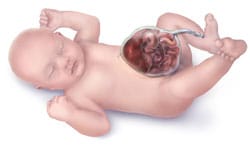What is an omphalocele?
An omphalocele is a birth defect in which the infant’s intestine or other abdominal organs stick out of the belly button (navel). In babies with an omphalocele, the intestines are covered only by a thin layer of tissue and can be easily seen.
An omphalocele is a type of hernia. Hernia means “rupture.”
Causes, incidence, and risk factors
An omphalocele develops as a baby grows inside the mother’s womb. The muscles in the abdominal wall (umbilical ring) do not close properly. As a result, the intestine remains outside the umbilical cord.
Approximately 25 – 40% of infants with an omphalocele have other birth defects. They may include genetic problems (chromosomal abnormalities), congenital diaphragmatic hernia, and heart defects.
Symptoms
An omphalocele can be clearly seen, because the abdominal contents stick out (protrude) through the belly button area.
There are different sizes of omphaloceles. In small ones, only the intestines stick out. In larger ones, the liver or spleen may stick out of the body as well.
Signs and tests
Prenatal ultrasounds often identify infants with an omphalocele before birth. Otherwise, a physical examination of the infant is enough for your health care provider to diagnose this condition. Testing is usually not necessary.
Treatment
Omphaloceles are repaired with surgery, although not always immediately. A sac protects the abdominal contents and allows time for other more serious problems (such as heart defects) to be dealt with first, if necessary.
To fix an omphalocele, the sac is covered with a special man-made material, which is then stitched in place. Slowly, over time, the abdominal contents are pushed into the abdomen.
When the omphalocele can comfortably fit within the abdominal cavity, the man-made material is removed and the abdomen is closed.
Sometimes the omphalocele is so large that it cannot be placed back inside the infant’s abdomen. The skin around the omphalocele grows and eventually covers the omphalocele. The abdominal muscles and skin can be repaired when the child is older to achieve a better cosmetic outcome.
Expectations (prognosis)
Complete recovery is expected after surgery for an omphalocele. However, omphaloceles often occur with other birth defects. How well a child does depends on which other conditions the child also has.
If the omphalocele is identified before birth, the mother should be closely monitored to make sure the unborn baby remains healthy. Plans should be made for careful delivery and immediate management of the problem after birth. The baby should be delivered in a medical center that is skilled at repairing omphaloceles. The baby’s outcome is improved if he or she does not need to be taken to another center for further treatment.
Parents should consider screening their unborn baby for other genetic problems that are associated with this condition.
Complications
- Death of the intestinal tissue
- Intestinal infection

No comments:
Post a Comment